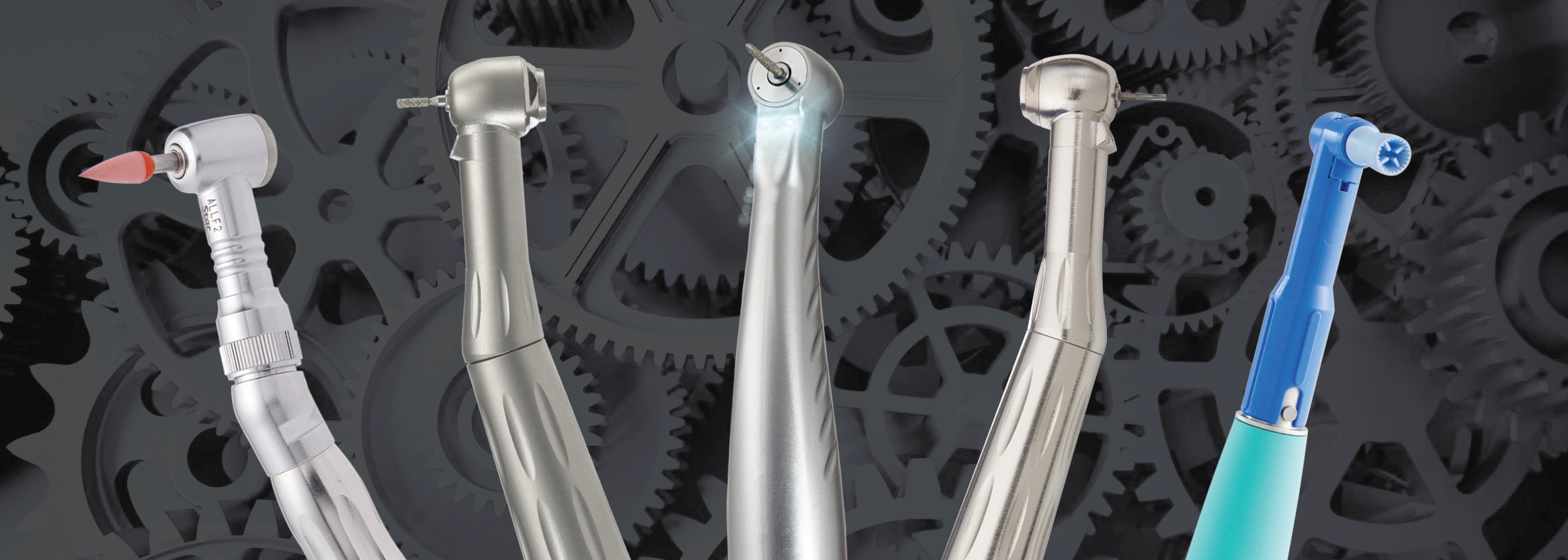Modern dental practice doesn’t mean only elite clients but also the occupancy of posh dental products. As a premium dentist, you understand the importance of having top-quality tools for your dental practice. One of the prime requisites of dental practice is Dental handpiece, which helps to perform all major dental procedures such as cutting, abrading, burnishing, finishing or polishing tooth tissues or a restoration. Thus, choosing a right product becomes important for your patients as well as for your own practice.
In this blog, we’ll guide you through the process of selecting the perfect premium handpiece, considering various factors such as parts, types, and function.
- Classification of handpiece on the basis of anatomy
Dental handpieces categorization can be done on the ergonomic design as well. Some of the crucial factors to be considered for selecting the right handpiece are handpiece body, head, grip, bur holding type, colour -coding, cartridge and coupling types and most important is the weight. Understanding these parts will help you make an informed decision and selecting a handpiece with higher efficiency and optimal performance.
Likewise on the basis of head design, they can be characterized as standard, mini and torque.


Similarly on the basis of bur holding type, it can be classified as screw-type chuck, airmatic bur changer and ultra push system.
Presence of colour coded handpiece are in now a day. The significance of colour bands on the handpiece shows the functionality output of the handpiece.
- Like Blue colour shows no change in speed.
- Green colour band shows reduction in outcome speed .
- Red colour band shows increase in outcome speed.
Weight of handpiece
Plays a supreme role in selecting the handpiece. Earlier Brass is the used commonly in handpiece manufacturing. Although it is a relatively easy to machine and inexpensive material, on the other hand it is soft and susceptible to denting as well.
Thereafter, Stainless steel is take the edge to make handpiece bodies. Steel is lighter and stronger than brass, but its use results in higher manufacturing costs, so the prices are generally higher.

Current state-of-the art in handpiece manufacture is titanium, which is almost 40% lighter and stronger and more resistant to the corrosive effects of autoclaving.
Hence, the design of a handpiece plays a vital role in practising over the patients and majorly all these factors have been fulfilled by the Premium Range of handpiece.
- Classification of handpiece on the basis of speed
In Physics, speed is defined as the number of revolution per minute or RPM that means how a thing make a full turn during a minute.
However, in dentistry speed is defined as not only to the revolutions per minute, but also to the Surface feet per unit time of contact that the tool has with the work to be cut.
Most followed classification of handpieces on the basis of speed is Marzouk classification, which is explained as
- Ultra low speed – 300 -3000 rpm
- Low or slow speed- 3000 -6000 rpm
- Medium or intermediate speed – 20,000 – 45,000 rpm
- High speed- 45,000 – 1,00,000 rpm
- Ultra-high speed – more than 1,00,000 rpm
Primarily two types of dental handpiece are used commonly in dentistry. They are high-speed and low-speed handpieces.
High-speed handpieces, also known as dental drills, are used for cutting tooth structure, whereas, low-speed handpieces are designed for polishing, cleaning, and endodontic procedures.
All the high-end dental clinics have both the forementioned types available for catering any kind of dental procedures.
- Classification on the basis of illumination
Dental practice of this era has become more precise and efficient and undoubtedly the enhancement in the technology of dental handpiece makes a major difference. One of the blessings being the introduction of Illuminated handpieces in dental practice.
If we talk about history, the evolution from glass fibres to cellular optics to introduction of LED light in dental handpieces have proved a boon.
Indeed, the final result is better and précised working with minimal efforts and time and the lesser strain to practioner’s eyes.
All the premium range handpieces are equipped with best possible illumination feature.

- Classification on the basis of sound level
Sound levels are associated with air flow through the handpiece head. It just subtracts from your working environment. It doesn’t affect only the working dentist but also enhance the apprehension and anxiety of patients.
Earlier, the handpieces have come up with the noise level of above 80dB but newer premium handpiece models with lower noise levels have become available, operating in a range of 58-71 decibels (dB).
- Classification on the basis of connector types
Different dental handpiece connector types are used to attach the handpiece to the dental unit.
Common connectors include four-hole and six-hole connections. To ensure seamless integration, make sure your premium handpieces are compatible with your dental unit’s connectors.
- Dental Drill Types
Selecting the appropriate dental drill types for your premium dental practice is essential for delivering the best possible patient care. Some common dental drill types include diamond burs for cavity preparation, carbide burs for removing dental material, and end-cutting burs for shaping tooth structure.
The premium range handpieces are compatible with most of the types of bur irrespective of their functioning , manufacturing , size and shape.
Thus, thereby increasing the overall horizon of working scenario with better options and availability.
- Dental Handpiece Oil Spray & Autoclavability
Maintaining your premium handpieces is crucial for their longevity and performance. Dental handpiece oil spray is used to lubricate the internal components of the handpiece, ensuring smooth operation.
Sterilization is utmost important now-a- days for both the patient as well as dentist. Only the premium range handpieces are autoclavable as nominal handpieces can’t resist such harsh temperature and pressure.
Consistent cleaning and sterilization are also vital for maintaining a hygienic and efficient dental environment.
- Dental Handpiece Cartridge & Repair
The dental handpiece cartridge houses the turbine and bearings, which are responsible for the rotation of the handpiece.
A dental handpiece repair kit can help you replace worn or damaged parts, extending the life of your premium handpiece and ensuring optimal performance for your patients.

- Dental Handpiece Holder & Storage
A dental handpiece holder allows for proper storage and organization of your handpieces, ensuring they are easily accessible during dental procedures.
Selecting a holder that accommodates various dental handpiece types and coupling types is essential for a versatile and efficient dental practice as it maintains the handpiece as well.
Conclusion:
The truth that introduction of Dental Handpieces have been revolutionary and none other invention has attracted the dentist to such an extent. Thus, choosing the perfect premium handpiece for your high-end dental practice involves considering the handpiece parts, types and function, as well as the dental handpiece connector types and dental drill types. Prioritize proper maintenance using dental handpiece oil spray and dental handpiece repair kits to extend the life of your instruments. By keeping these factors in mind, you can invest in a top-quality, reliable handpiece that enhances your dental practice and provides exceptional patient care.


